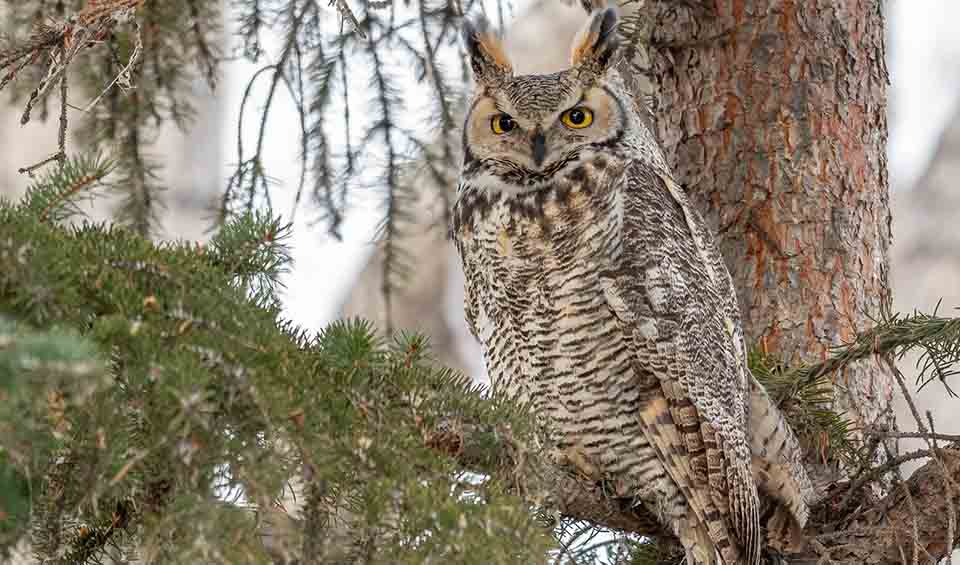One of the most powerful and widespread owls in the Americas. Found from the Arctic tundra of Canada all the way down to the jungles of South America, this owl has adapted to nearly every type of habitat — forests, deserts, swamps, cities, and everything in between. Its versatility and strength make it one of the top nocturnal predators wherever it lives.
One of the great horned owl’s most recognizable features is its large size and impressive appearance. It has a stocky body, powerful talons, and a broad, rounded head marked by feathery tufts — the “horns” that give it its name. These tufts aren’t ears but rather are used for communication and camouflage, breaking up the outline of its head among branches. Its yellow eyes are bright and intense, perfect for low-light hunting, and its plumage — usually a mix of brown, gray, black, and white — helps it blend seamlessly into tree bark or rocky landscapes.
The great horned owl is a fearless hunter known for taking down a wide variety of prey, from small mammals like rabbits and rodents to larger animals like skunks, birds, reptiles, and even other raptors. Thanks to its powerful grip, it can crush prey instantly. Its diet is so diverse that it can survive in areas where other predators might struggle. It hunts mostly by perching silently and watching, then swooping down with a fast, quiet strike.
The great horned owl has some of the most powerful talons in the bird world — its grip strength can reach about 136 kilograms (300 pounds) per square inch, enough to easily pierce and hold struggling prey. Another fascinating detail: its feather structure allows it to fly almost completely silently, thanks to soft-edged flight feathers that muffle the sound of air passing over the wings.
Distribution
 Argentina
Argentina Belize
Belize Bermuda
Bermuda Bolivia
Bolivia Brazil
Brazil Canada
Canada Colombia
Colombia Costa Rica
Costa Rica Ecuador
Ecuador El Salvador
El Salvador Falkland Islands
Falkland Islands French Guiana
French Guiana Guatemala
Guatemala Guyana
Guyana Honduras
Honduras Mexico
Mexico Nicaragua
Nicaragua Panama
Panama Paraguay
Paraguay Peru
Peru Saint Pierre
Saint Pierre South Georgia
South Georgia Suriname
Suriname United States
United States Uruguay
Uruguay Venezuela
VenezuelaAnything we've missed?
Help us improve this page by suggesting edits. Glory never dies!
Suggest an editGet to know me
Terrestrial / Aquatic
Altricial / Precocial
Polygamous / Monogamous
Dimorphic (size) Monomorphic
Active: Diurnal / Nocturnal
Social behavior: Solitary / Pack / Herd
Diet: Carnivore / Herbivore / Omnivore / Piscivorous / Insectivore
Migratory: Yes / No
Domesticated: Yes / No
Dangerous: Yes / No




